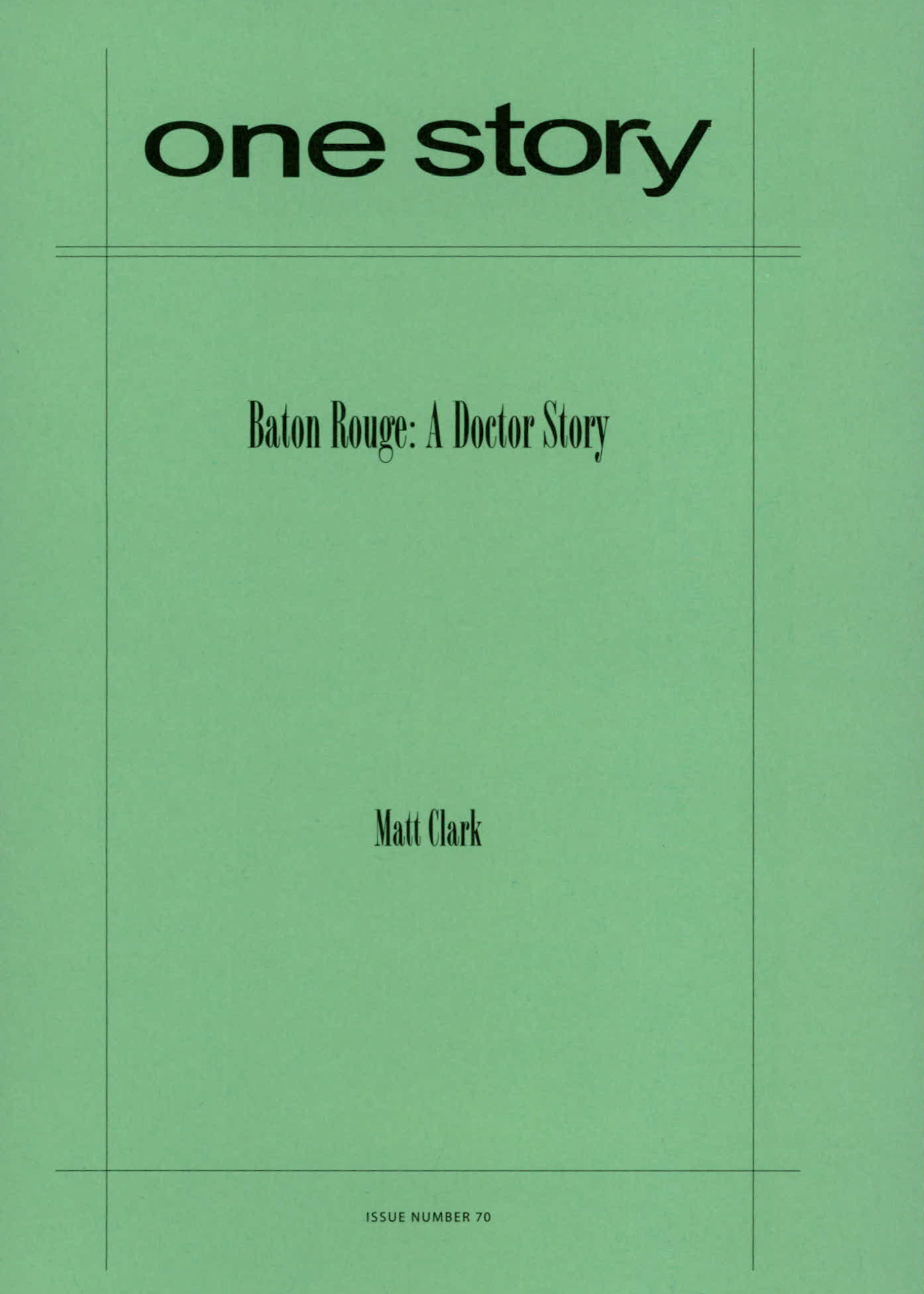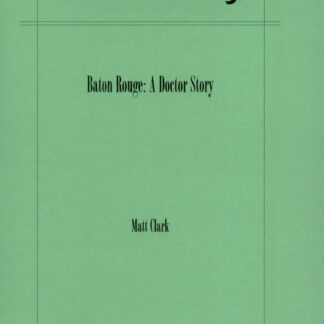
Baton Rouge: A Doctor Story
$2.50
34 in stock
Excerpt
The doctors’ wives have planned the picture carefully, chosen their husbands’ outfits with attention to colors and patterns, sent lab coats to dry cleaners. The coats have come back pressed and whiter than choir robes. The doctors’ wives comment on how good a job the dry cleaner did. The doctors’ wives use the same dry cleaner.
The doctors’ wives planted the garden in which the doctors stand, the garden in front of the Health Center sign. The sign is concrete, but covered in earthen tiles; the lettering is brass. The doctors’ wives polish the letters using an expensive brass polish Dr. Hileman’s wife bought in England. The garden is not very big. Being in the deep shade of a large oak, the garden’s contents had to be carefully chosen by Dr. Teal’s wife, who took a course in botany.
The concrete sign was designed by Dr. West’s wife. She was an art major in college. She met Dr. West at a gallery in which her works were displayed. She still paints, time permitting. The other doctors’ wives admire the sign’s sturdiness and its shiny letters. Architecturally, the sign complements the Health Center’s slightly Spanish flavor. The doctors’ wives like things to match.
Matt Clark
Matt Clark’s novel Hook Man Speaks (Putnam/Berkeley, 2001) was chosen as the inaugural title for The Texas Monthly Author Series. When he died in 1998, at age thirty-one, Matt was coordinator of the Louisiana State University creative writing program. His stories have appeared in Alaska Quarterly Review, Gulf Coast, Flyway, and the anthology Texas Bound II, and are forthcoming in the Southwest Review and the Yalobusha Review. While a graduate student at LSU, he was fiction editor of New Delta Review, which now sponsors the Matt Clark Prize.
Hannah Tinti on “Baton Rouge: A Doctor Story”
“Baton Rouge” was brought to One Story by Matt Clark’s literary executors & friends, authors Josh Russell and Michael Griffith. Together they answered a few questions about Matt’s writing in this issue’s Author Q&A below.
Q&A by Hannah Tinti
Hannah Tinti: How did you both meet Matt Clark? And what were your first impressions of him?
Josh Russell: Matt enrolled in the MFA program at LSU in 1991, and I met him in a fiction workshop. I remember three things about Matt and that workshop: 1) He later claimed the rainbow-colored Rasta hat I wore to it made him fear me (I think he was afraid of my scary fashion choices), 2) He brought in a piece of what was then a little-known book called Generation X and another new student prepared an angry speech in response to it and to Matt’s taste (she didn’t get the joke), and 3) After reading the first story he turned in I called Matt up to tell him how much I liked it, and he seemed taken aback by the call. When I consider it now, I realize that it might not have been appropriate to call him at 1a.m.-but it was a really good story.
Michael Griffith: I too met him in workshop, and besides our fellow workshopper’s harrowing rant about the Coupland book (I found this as nourishing . . . as . . . ice), what I most remember is that when we went around the room introducing ourselves and naming an admired writer, Matt broke the earnest string of Joyces and Faulkners and Morrisons and Dantes by naming Dr. Seuss. He’d heard enough bloviating about Finnegans Wake; it was time somebody spoke up for Hop on Pop.
HT: What can you tell our readers about “Baton Rouge: A Doctor’s Story”? Do you know when Matt wrote it, or anything about his inspiration?
JR: I think this was a later story, but I would like to believe that it was one that he wrote the week in 1994 when he, Michael and I challenged each other to write a one-page story a day for five days. I dutifully wrote my five single-page stories, one of which wasn’t stupid, Michael cheated and wrote one very good five-part story, and Matt wrote five full-length stories, each at least ten pages long. And they were all amazing. He could do that; it was scary.
MG: My memory is similar. I’m pretty sure this wasn’t one of the ones he produced during our story-a-day experiment, but I too associate it with that time. There was a lot of cross-pollination going on that week—by which I mean, in my case, shameless theft of the pollen of others (I filched a premise from Josh), and in Josh and Matt’s, plain old cross-pollination. Josh was working on a story called “Natchez” around then, and I think the notion of a story named after Baton Rouge came from that. And what I worked on that week (fine, Josh—the story that was my cheating, lowlife dodge that week) was told in fragments, in something like the mosaic style Matt uses in “Baton Rouge.” One other thing: My recollection, which may or may not be right, is that Matt’s story changed dramatically after its first draft. The sexual liaison between Drs. Stephens and Teal was a minor element at first, one secret among others, but in revision it came to loom larger and larger, become more and more the axis around which everything else revolved.
HT: How did Matt develop as a writer? Was “Baton Rouge” a later work, or something he wrote earlier in his career?
MG: I remember that the first story he workshopped at LSU had to do with a boy who had a levitating pet whale that he walked on a tether. I think of it as Moby-Matt, but that wasn’t the whale’s name. Do you remember, Josh? The Carverites and domestic realists in the class had no idea what to make of the story, and frankly I didn’t either, at first. But I knew right off that this was an imaginative world I wanted to enter and to revel in.
JR: How did I manage to forget that whale? I’m so glad to be reminded, and I wish I could remember its name, but I can’t. When he came to LSU, Matt was writing magical realist Texas tall tales; then he got kicked around in workshop and in response wrote some very good but very traditional stories, and then after he graduated, he brought together the wildness he had when he got to LSU and the craft that he honed while there. His MFA thesis, the novel Hook Man Speaks, is a good example of that, I think, and in different ways, so is “Baton Rouge.”
MG: As Josh says, Matt later wrote some more conventional and more autobiographical stories (no more drinking goats and chameleons that writhe together to imitate masterworks of art and so on), and toward the end of his life—the final version of “Baton Rouge” is definitely a late story—he found new ways to marry his technical skills to his sense of exuberance and whimsy and to make them work together, beautifully.
HT: The city of Baton Rouge is still recovering from the recent hurricanes, and it was hard not to think of the devastation while reading Matt’s piece. Can you talk a little about his connection to Louisiana, as a place? And how it affected him as a writer?
MG: Place was crucially important to Matt, and initially Baton Rouge was most important as a counterpart to the arid west Texas that was his favorite landscape, the home to almost all of his earlier fiction. Red Stick was a damp, lush, polluted, blessedly weird Not-Texas. His collection is called South/West, but he wrote its two sections in reverse order: first “West” and then—the longer he spent in Baton Rouge and the more it came to be a second home—“South.”
JR: Baton Rouge was a good place to be in the early ‘90s. The beer and rents were cheap, and something weird was always happening. Hurricane Andrew came through in August 1992, and that was weird. Matt wrote a story about a hurricane party after attending one during Andrew; he wrote a lot of stories about Louisiana, in fact, so I guess it got into his blood. I think that happened to a lot of us who went to LSU, thank goodness.
HT: What can you tell us about the Matt Clark prize at New Delta Review?
MG & JR: Matt was fiction editor of NDR when he was a grad student, and when he was running the LSU writing program, he worked hard to get more money for the Review. In the end, the managing editor position was a funded graduate assistantship—it had been volunteer work until then. The Prize is $100 and publication, both for fiction and poetry. The Prize is supported by The Matt Clark Fund, which will receive the honorarium for this story. Matt loved little magazines, and so this is a wonderful way to remember him. The Fund also supports the Matt Clark Prizes in fiction and poetry for work published in LSU’s undergraduate creative writing journal, Delta. For more info on this, visit http://www.english.lsu.edu/journals/ndr/clark_prize/index.htm.
HT: What’s the next step, as far as promoting Matt Clark’s writing? Is it possible that another book of his work will be published?
MG & JR: We’re readying a collection of Matt’s stories, South/West, for submission. Recently a former student of Matt’s who is now fiction editor at the Yalobusha Review asked if there were any unpublished stories in the collection that we might let him consider, and when we did some checking, we were surprised to find that four of the pieces in South/West had not yet seen print. Three of those four are now being published—in One Story, the Southwest Review, and the Yalobusha Review. It’s a good book, and we’re hoping a smart editor snaps it up.
Q&A by Hannah Tinti
- HT: ?
- MC:
- HT: ?
- MC:
- HT: ?
- MC:
- HT: ?
- MC:
- HT: ?
- MC:
- HT: ?
- MC:
